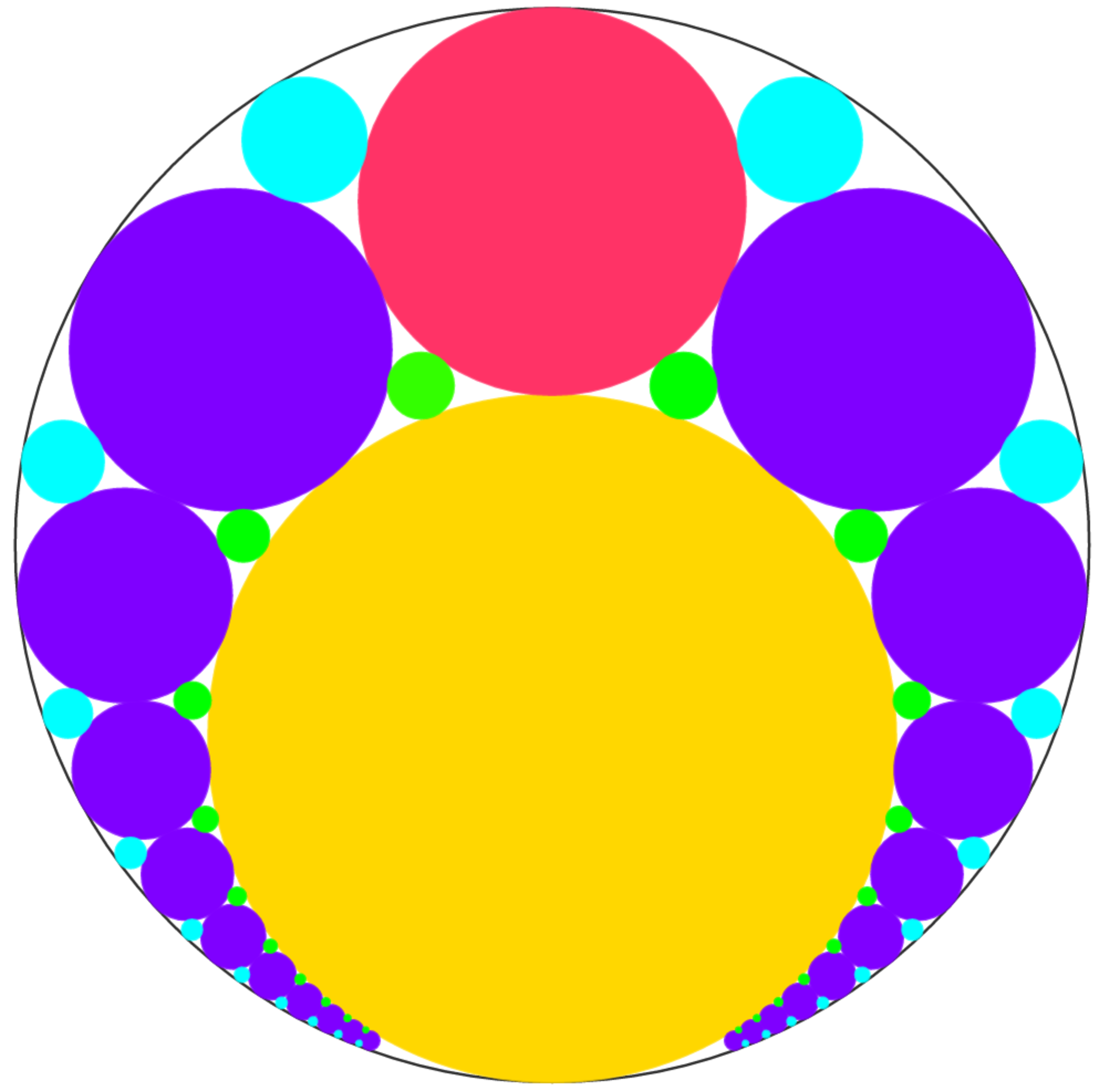Descartes Sangaku : The Aberration
- The diagram shows a circle with radius 25. Inside this circle, we inscribe a yellow circle with radius 16 and a red circle with radius 9.
- We pack the space inside the circle with radius 25 with an infinite number of purple, blue (cyan) and green circles.
- The radius of the 100th purple circle can be expressed as : b a where a and b are coprime positive integers
- The radius of the 100th green circle can be expressed as : d c where c and d are coprime positive integers
- The radius of the 100th blue (cyan) circle can be expressed as : f e where e and f are coprime positive integers
- Evaluate : f − d − c ⋅ b − a ⋅ e
-
NOTE
: Consider the circles only on the left or on the right side to count the circles from 1 to 100. To differenciate cyan circles and purple circles : Cyan circles are smaller and purple circles are the biggest

The answer is 550560.
This section requires Javascript.
You are seeing this because something didn't load right. We suggest you, (a) try
refreshing the page, (b) enabling javascript if it is disabled on your browser and,
finally, (c)
loading the
non-javascript version of this page
. We're sorry about the hassle.
2 solutions
By Descartes’ Theorem , the radii p n of the purple circles are defined by p n 1 = 1 6 1 + p n − 1 1 − 2 5 1 + 2 1 6 p n − 1 1 − 1 6 ⋅ 2 5 1 − 2 5 p n − 1 1 , which with p 0 = 9 can inductively shown to be p n = 8 1 n 2 + 4 0 0 3 6 0 0 . Therefore, p 9 9 = 8 1 ⋅ 9 9 2 + 4 0 0 3 6 0 0 = 7 9 4 2 8 1 3 6 0 0 and p 1 0 0 = 8 1 ⋅ 1 0 0 2 + 4 0 0 3 6 0 0 = 2 0 2 6 9 , so a = 9 and b = 2 0 2 6 .
Also by Descartes’ Theorem, the radius of the 1 0 0 th green circle is g 1 0 0 = p 9 9 1 + p 1 0 0 1 + 1 6 1 + 2 p 9 9 p 1 0 0 1 + 1 6 p 9 9 1 + 1 6 p 1 0 0 1 1 = 8 0 2 4 8 9 9 0 0 , so c = 9 0 0 and d = 8 0 2 4 8 9 .
And the radius of the 1 0 0 th cyan circle is c 1 0 0 = p 9 9 1 + p 1 0 0 1 − 2 5 1 + 2 p 9 9 p 1 0 0 1 − 2 5 p 9 9 1 − 2 5 p 1 0 0 1 1 = 3 2 0 8 8 4 9 3 6 0 0 , so e = 3 6 0 0 and f = 3 2 0 8 8 4 9 .
Therefore, f − d − c ⋅ b − a ⋅ e = 3 2 0 8 8 4 9 − 8 0 2 4 8 9 − 9 0 0 ⋅ 2 0 2 6 − 9 ⋅ 3 6 0 0 = 5 5 0 5 6 0 .
What would we do without that theorem am i right? ;)
this question should be level 100000, at least level 5. i'm going mad how is this level 4
Log in to reply
Ahaha oh well...i think the website should do more than 5 levels anyway...there is a big difficulty gap between some level 5 problems and other level 5 problems. Moreover it should be discussed why a problem is difficult to help better categorize
Did you actually make this problem, or did you get it from somewhere else?
All my problems are original. Althought this figure could have been studied in the past since this pattern is quit basic.
It's a brilliant problem.
I've actually made a problem myself here . I really want to get to 1,000 solvers, so please could you share the link elsewhere on Brilliant?
Thank you . Sure of course its great to see such a young problemist !
Then R g 1 0 0 = 8 0 2 4 8 9 9 0 0 then c = 9 0 0 and d = 8 0 2 4 8 9
B l u e c i r c l e s : The radii of the circles are in the sequence : 1 2 4 9 3 6 0 0 , 1 8 9 7 3 6 0 0 , 3 1 9 3 3 6 0 0 , 5 1 3 7 3 6 0 0 , 7 7 2 9 3 6 0 0